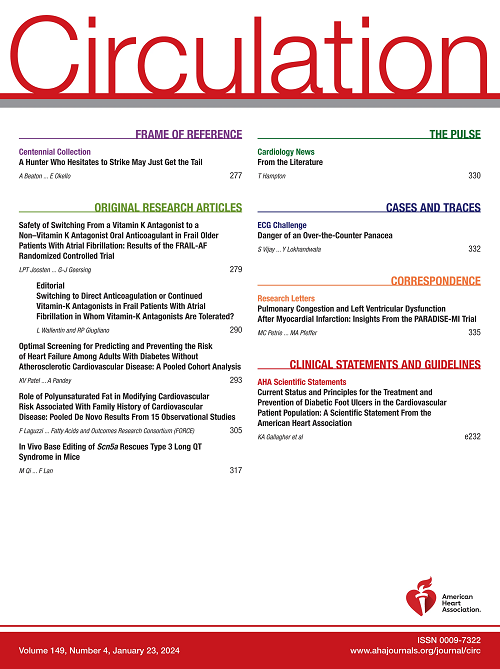工作年龄成人房颤筛查与心血管预后
IF 38.6
1区 医学
Q1 CARDIAC & CARDIOVASCULAR SYSTEMS
引用次数: 0
摘要
背景:心房颤动(AF)的早期检测对于预防缺血性卒中和其他心血管并发症至关重要。然而,房颤在一般中年人群中的发病率和预后尚不清楚。在日本,员工的年度健康检查包括强制性心电图,这为填补这一证据空白提供了一个独特的机会。方法:本回顾性队列研究旨在评估日本普通工作人群筛查检测到房颤的发病率和随后的心血管结局,使用日本健康保险协会数据库,该数据库覆盖了该国四分之一的工作年龄人口。从2015年4月至2020年3月期间接受年度健康筛查的35至59岁个体中,排除有心血管病史的个体,确定在筛查心电图时首次发现房颤的个体。主要终点为缺血性卒中住院。次要结局是全因死亡和因心力衰竭住院。使用调整后的亚分布风险模型与匹配对照比较,评估筛查检测到的房颤与预后之间的关系。结果在纳入我们研究的950万人中,检测到11790例房颤初始病例(10万人年42.4例[95% CI, 41.6-43.1])。与非房颤患者相比,房颤患者年龄更大(平均年龄,50.9岁对46.3岁),男性更可能(91.6%对63.6%)。在这些筛查出房颤的个体中,缺血性卒中、全因死亡和心力衰竭的3年发病率分别为1.83% (95% CI, 1.57-2.09)、0.78% (95% CI, 0.61-0.95)和3.87% (95% CI, 3.50-4.24)。与年龄和性别匹配的对照组相比,房颤患者发生缺血性卒中(危险比,5.38 [95% CI, 4.51-6.42])、全因死亡(危险比,1.98 [95% CI, 1.66-2.36])和心力衰竭(危险比,18.35 [95% CI, 15.10-22.31])的风险更高。结论:在日本中年人群中,每2400例筛查心电图中就有1例检测到房颤,与没有房颤的人相比,房颤的缺血性卒中和心力衰竭的相对风险更高。这些发现强调了筛查检测到房颤与卒中和心力衰竭的关联,值得进一步研究房颤作为心力衰竭的早期征兆,以及在普通中年人群中检测到房颤后的最佳心血管风险降低策略。本文章由计算机程序翻译,如有差异,请以英文原文为准。
Screening-Detected Atrial Fibrillation and Cardiovascular Outcomes in Working-Age Adults.
BACKGROUND
Early detection of atrial fibrillation (AF) is essential for preventing ischemic stroke and other cardiovascular complications. However, the incidence and prognosis of AF in the general middle-aged population remain unclear. In Japan, annual health screenings for employees include mandatory ECGs, offering a unique opportunity to fill this evidence gap.
METHODS
This retrospective cohort study aimed to evaluate the incidence and subsequent cardiovascular outcomes of screening-detected AF in the general working population in Japan, using the Japan Health Insurance Association database, which covers one-quarter of the working-age population of that country. From individuals 35 to 59 years of age who underwent annual health screenings between April 2015 and March 2020, excluding those with a history of cardiovascular disease, those with initial AF detection upon screening ECGs were identified. The primary outcome was hospitalization for ischemic stroke. The secondary outcomes were all-cause death and hospitalization for heart failure. The association between screening-detected AF and outcomes was evaluated using adjusted subdistribution hazard models compared with matched controls.
RESULTS
Among 9.5 million individuals included in our study, 11 790 initial AF cases (42.4 of 100 000 person-years [95% CI, 41.6-43.1]) were detected. Individuals with AF were older (mean age, 50.9 versus 46.3 years) and more likely to be male (91.6% versus 63.6%) compared with non-AF cases. Among these individuals with screening-detected AF, the 3-year incidences of ischemic stroke, all-cause death, and heart failure were 1.83% (95% CI, 1.57-2.09), 0.78% (95% CI, 0.61-0.95), and 3.87% (95% CI, 3.50-4.24), respectively. Compared with age- and sex-matched controls, individuals with AF had a higher risk of incident ischemic stroke (hazard ratio, 5.38 [95% CI, 4.51-6.42]), all-cause death (hazard ratio, 1.98 [95% CI, 1.66-2.36]), and heart failure (hazard ratio, 18.35 [95% CI, 15.10-22.31]).
CONCLUSIONS
AF was detected in one out of 2400 screening ECGs among the middle-aged population in Japan, with higher relative risks of ischemic stroke and heart failure, compared with those without AF. These findings highlight the association of screening-detected AF with stroke and heart failure, warranting further study into AF as an early sign of heart failure and optimal cardiovascular risk reduction strategies after AF detection in the general middle-aged population.
求助全文
通过发布文献求助,成功后即可免费获取论文全文。
去求助
来源期刊

Circulation
医学-外周血管病
CiteScore
45.70
自引率
2.10%
发文量
1473
审稿时长
2 months
期刊介绍:
Circulation is a platform that publishes a diverse range of content related to cardiovascular health and disease. This includes original research manuscripts, review articles, and other contributions spanning observational studies, clinical trials, epidemiology, health services, outcomes studies, and advancements in basic and translational research. The journal serves as a vital resource for professionals and researchers in the field of cardiovascular health, providing a comprehensive platform for disseminating knowledge and fostering advancements in the understanding and management of cardiovascular issues.
 求助内容:
求助内容: 应助结果提醒方式:
应助结果提醒方式:


